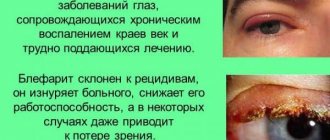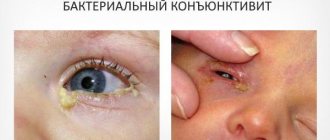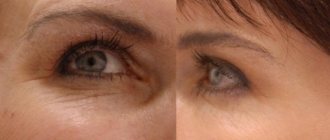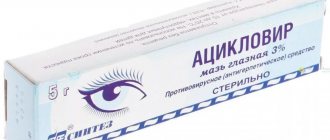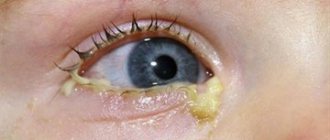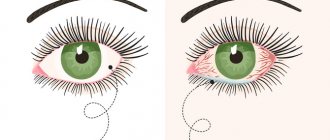Normally, in an adult, the mucous membrane of the eye produces a film of mucus, which performs a protective function. A small amount of white mucus the morning after sleep is normal. But you should be wary if purulent discharge appears instead of mucus. They can signal problems in the human body.
So why do a person’s eyes begin to fester? This manifestation may indicate various diseases of the visual system. Only an ophthalmologist can make the correct diagnosis. The most common reasons for such discharge are:
- conjunctivitis;
- corneal ulcer;
- chalazion or stye;
- dry eye syndrome.
We will consider all these diseases below and tell you what to do in such cases.
Eyes fester - reasons
In an adult, there are a number of reasons why the eyes may fester. Eye diseases that cause purulent discharge from the eyes:
1.Conjunctivitis
. Eye inflammation can be caused by bacteria, viruses, or have an allergic nature. Discharge from the eyes can be very profuse. With bacterial conjunctivitis, the discharge from the eyes can be very thick, yellow-green in color, and cause the eyes to become very sticky. With allergic inflammation, the discharge from the eyes is more watery and yellowish in color.
2.Other eye infections
. In addition to conjunctivitis, there may be other diseases in the eye that cause purulent discharge from the eyes. These include ocular herpes and fungal keratitis.
3.Corneal ulcer
. A corneal ulcer causes active suppuration from the eyes. It is the result of an untreated eye injury. May lead to complete loss of vision.
4.Dacryocystitis
. Inflammation of the lacrimal sac causes swelling and redness of the inner corner of the eye. When you press on the area of the lacrimal sac, copious yellow discharge appears.
5.Blepharitis
. Acute or chronic inflammation of the eyelids causes damage to the hair follicles of the eyelashes. This disrupts the normal functioning of the meibomian glands. Swelling and itching of the eyelids appears, the eyes fester, usually in the morning. Discharge from the eyes is foamy, yellow-green in color.
6. Stye or chalazion
. Acute inflammation in the hair follicle or when the meibomian gland is blocked is also accompanied by copious purulent discharge. In this case, the affected eyelid is swollen and red. Often, after a bath or visiting a steam room, the eyes fester, then the eyelid swells and other symptoms of stye or chalazion appear.
7.Dry eye syndrome
. Chronic inflammation of the mucous membrane and edges of the eyelids causes the development of dry eye syndrome. A large amount of mucopurulent discharge appears. Symptoms of dry eye include redness of the eyes, burning sensation, blurry vision and foreign body sensation. Very often, people with dry eye syndrome complain that their eyes fester in the morning, after sleep. However, this is not pus, but accumulated mucous secretions.
Treatment with medications
The presence of pus indicates that a bacterial infection has joined the viral problem or allergic reaction, which requires treatment with antibacterial drugs.
All types of conjunctivitis in adults should be treated after consulting an ophthalmologist.
Most often, with this course of the disease, antibiotics are prescribed in the form of the following eye drops:
- Tobrex (drip 4-5 times/day, no longer than 7 days).
- Tsipromed (every 90-120 minutes, no longer than 10 days).
- Levomycetin (after 8 hours, up to 10 days).
- Floxal (after 6-12 hours, up to 7 days).
- Oftaquix (up to 8 times/day, no longer than 5 days).
Antibacterial eye drops have many contraindications.
For those who treat inflammation at home, it is important to remember that to prevent infection, the second eye should also be instilled (in the same doses).
Treatment
Small mucous discharge from the eyes is harmless. However, if you notice a change in color and quantity, your eyes turn red, or severe itching appears, then contact your ophthalmologist.
When the eyes fester due to an eye infection, the doctor will prescribe treatment: antibacterial or antiviral medications. In case of allergies, antihistamine drops or ointments are prescribed to relieve symptoms.
Treatment with folk remedies
Warm eye compresses can help relieve symptoms of itching and general visual discomfort, and will also help remove purulent discharge from the eyes. Traditionally, warm compresses are made from herbal remedies. Chamomile decoction is very good at relieving symptoms of inflammation.
When the discharge is very sticky, then before compresses it is necessary to moisten a clean napkin in warm water and place it on the eyelids to soften the mucus and remove all crusts from the eyes.
Corneal ulcer
A corneal ulcer can be caused by various factors - mechanical trauma to the eye, eye burns, as well as various dangerous bacteria and viruses. Symptoms of this disease are pain in the eye, increased sensitivity to light, redness of the cornea, lacrimation, and copious discharge of pus. Treatment of patients with corneal ulcers usually takes place in an ophthalmological hospital. Anti-inflammatory and anti-infective treatment is most often prescribed. In severe cases, surgery is indicated - keratoplasty (cornea transplant).
Diagnosis and treatment of purulent eye diseases
The success of treatment is determined by competent comprehensive diagnosis. For purulent pathologies of the eye, the following studies may be prescribed:
- smear to study bacterial flora;
- tests for viral infection;
- fungal infection tests;
- checking for demodicosis;
- chlamydia test;
- allergy tests.
When treating purulent eye infections, broad-spectrum antibiotics are used, which are effective against the specific pathogen that caused the purulent inflammation. Methods of drug administration - instillation or injection (it is necessary to introduce the drug closer to the site of pathology (parabulbar, retrobulbar, subconjunctival) into the eye cavity.
Intracameral, intravitreal, and suprachoroidal administration are also used.
The complex use of antibiotics (sometimes several) in the form of intravenous injections, parabulbar and subconjunctival injections in combination with intravitreal injection into the eye cavity is usually effective.
Diagnostic measures are based on the use of the following methods:
- Biomycoscopy of the eyeball using a slit lamp.
- Bacteriological diagnosis of purulent discharge.
- Ophthalmological examination to exclude complications regarding fiber.
- Ultrasound.
- Determination of visual acuity.
Carrying out biomicroscopy of the eye
First aid
When the eyes are red and fester in an adult, this means the beginning of a disease process. It is very important to provide primary care to the patient in a timely manner, since the successful outcome of subsequent treatment depends on the speed of appropriate actions.
The eyes of an adult are festering - what to treat first?
- The very first action in case of suppuration of the organ of vision is to remove accumulations of pus. All therapeutic actions are carried out with clean hands. To remove pus, you need to rinse your eyes with moderately warm boiled water, then moisten a small piece of sterile cotton wool in a furatsilin solution, and thoroughly rinse the organ of vision from the outer to the inner corner.
- Before contacting an ophthalmologist, you can use anti-inflammatory compresses based on chamomile or calendula decoction or brewed black tea. Lotions and compresses help reduce inflammation of the eye. The compress is kept on the inflamed area for about 5 minutes.
Reasons why suppuration appears in the eye of an adult
The following diseases can be the cause of suppuration:
Keratitis
photo of eye keratitis
This inflammation of the cornea causes vision loss. Discharge of pus is the main symptom of this disease. Additional symptoms are photophobia, inflammation and redness of the eye, pain in the cornea. It darkens, and the capillaries around it burst and form small blood spots and lines on the white of the eye.
Deterioration in vision does not appear immediately: over the course of one or two weeks, patients begin to complain of difficulties in reading, working, watching TV and eye fatigue.
The causes of keratitis are mainly neurogenic factors, burns, eye injuries, and herpes. It causes the formation of ulcers through vascular ingrowth . For diagnosis, ophthalmologists conduct a comprehensive examination of the eye based on clinical manifestations. How to treat a person's eyesore can be found here.
If you do not get rid of keratitis in time, there is a possibility of complications: blindness or the formation of a cataract.
Barley
barley diagram
Barley is a pathological process in which the sebaceous glands of the eye located at the edge of the eyelids become inflamed. These glands prevent the skin of the eyelids from wetting. If the eye is oversaturated with it, then clogging occurs. As a result, an environment favorable for the development and reproduction of bacteria, viruses, and infections is formed. A so-called abscess forms along the boundaries of the eyelid, which constantly increases, especially in the morning. Over time, it provokes sharp and nagging pain in the eyelid area.
Most often the disease is caused by demodicosis or staphylococcal bacteria. Infection occurs through contact with infected people or animals or by rubbing the eyes with dirty hands. In the second case, together with your hands, you bring millions of microbes and bacteria to the shell of the eye, which, if it does not cause illness, then injures the general immunity of the visual organ. Allergies to the skin around the eyes are eliminated with complex treatment: drugs in combination with compresses.
Demodicosis is a parasite, a small mite that is located at the roots of the eyelashes and causes itching and burning. The main source of the disease is wild, stray and even domestic animals. The main thing is not to scratch the eye, otherwise the infection and inflammation will spread completely to the entire eye. Also, you should not squeeze or press on the area where the stye is ripening, where the pus comes out. What are the generally accepted signs of glaucoma can be found here.
Allergy
Suppuration can be caused by allergies if a person has been in the area of exposure to the provoking allergen for a long time. In this way, the conjunctiva of the eye itself becomes inflamed and allergic conjunctivitis is formed. The late stage of the disease is precisely characterized by purulent discharge. How to treat internal stye on the eye can be found on the pages of our website.
Trachoma
The causative agent of trachoma is the pathogenic bacterium chlamydia. Damage to the eye occurs gradually. Each stage of the disease is characterized by an expansion of the focus of trachoma action. During the course of the disease, the eye begins to fester. If treatment is not taken promptly, surgery may be necessary. You can read about the prevention of astigmatism in children here.
Purulent conjunctivitis
definition table for purulent conjunctivitis
This is a pathological disease of the conjunctiva, which is characterized by its inflammation. The reason is the ingress of all kinds of bacteria, infections and viruses. This happens upon contact with an affected person or animal. The second possible infection option is rubbing your eyes with dirty hands or getting sand or dust particles into your eyes. The main symptom of the disease is suppuration.
Prevention
The main thing in the prevention of purulent eye diseases is compliance with hygiene and cleanliness rules:
- Use only personal hygiene items;
- If you wear contact lenses, follow all prescribed rules for storing and wearing them;
- Eat foods rich in vitamins (vegetables, fruits);
- Wash your hands regularly with soap or treat them with antiseptics or wet wipes;
- If you need to wipe or scratch your eyes, do not do it with dirty hands - use napkins.
Thus, suppuration of the eye can be caused by various reasons. Often this disease acts as one of the symptoms of a person’s underlying illness. When treating, it is important to use complex therapy and combine pharmaceutical drugs with traditional recipes. Maintain sterility and hygiene not only during the recovery period, but also in everyday life. This will help prevent re-infection or avoid complications.
Traditional treatment
The use of folk remedies for the discharge of pus from the eyes shows good results. Many treatment methods are universal and suitable for all diseases, regardless of their nature of origin. The following are considered especially effective:
- Tea brewing. You can also use used sachets by placing them on your eyelids for 15 minutes. You need to brew strong black tea. The cooled liquid is used to wash the eyes or use it as a lotion.
- Contrast compresses . It is necessary to prepare two containers with clean cold and warm water. Take several gauze swabs, dip them one by one in the liquid and apply to the problematic eye for 2 minutes. The treatment procedure consists of going through 3-7 cycles with cold and warm water.
- Seaweed therapy. This method can be used to treat purulent conjunctivitis, allergies or the consequences of injuries. To do this, you need to buy seaweed called “fucus” at the pharmacy. Three tablespoons of plant material are poured into a thermos and 450 ml of boiling water is poured. The liquid should infuse overnight. In the morning, the resulting infusion is poured into ice cube trays and frozen. The medicine is recommended to be used in the evening. To do this, take one cube out of the freezer and wipe the area around the eyes and eyelids with it.
Herbal treatment
For suppuration of the eyes, the use of medicinal herbs shows excellent results. The most effective recipes are:
- Chamomile decoction. Helps get rid of the inflammatory process, eliminate itching, burning, and discomfort. To carry out the treatment procedure, pour 265 ml of boiling water over a heaped spoon of plant material. The mixture is infused under the lid for 25 minutes, then filtered. Before use, the liquid is slightly warmed and a gauze swab is dipped into it. It is applied to the problematic eye for 15 minutes. The procedure is repeated every 1.5 hours.
- Rosehip flowers. To quickly cure your eyes, you need to use 100 g of fresh plant material. Rosehip flowers are poured with 210 ml of boiling water and kept under a closed lid for 5 hours. With the resulting liquid, lotions are made on the problematic eye.
- Calendula infusion . To prepare a healing liquid for suppuration, you need to take two tablespoons of plant material and pour 210 ml of boiling water over it. When the liquid has cooled, it is filtered and used as an eye lotion.
- The use of alcohol tincture of calendula. In especially severe cases, it is recommended to use a ready-made drug from a pharmacy. The alcohol tincture is diluted with water in a ratio of 1:10. The liquid is mixed with any vegetable oil in a ratio of 1:4. The resulting ointment is applied to the eyelids up to three times a day, which helps to get rid of pus in the shortest possible time.
- Application of marshmallow root infusion. You can treat suppuration of the eyes using a product made from 40 g of dried plant material and 200 ml of cold water. The components are mixed together and infused for 8 hours. The resulting liquid is used to treat the eyes daily at intervals of 3 hours.
